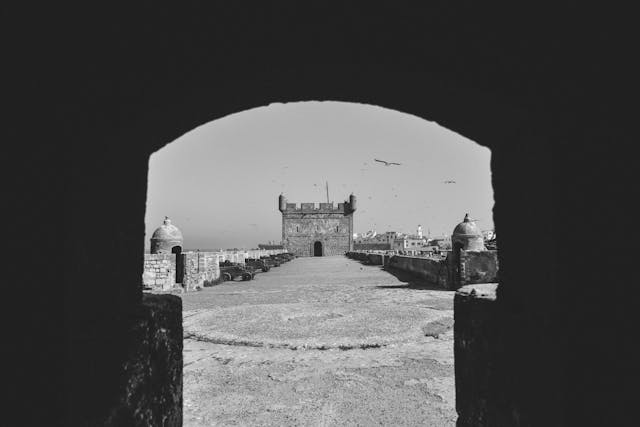Introduction: A Glimpse into Essaouira’s Past
Before it became the vibrant coastal city we know today, Essaouira was known as Mogador, a name steeped in history and legend. Nestled along the Atlantic coast of Morocco, Mogador served as a vital link between Africa, Europe, and the Middle East for centuries. Its strategic location made it a prized destination for traders, explorers, and settlers alike. In this article, we’ll uncover the ancient roots of Mogador, tracing its journey from a bustling Phoenician port to the culturally rich city of Essaouira.
Whether you’re a history enthusiast or planning your next trip, understanding Essaouira’s origins adds depth to your experience of this UNESCO-listed gem. Let’s dive into the story of Mogador—where it all began.
1. Mogador: The Name Behind the City
Mogador is believed to have originated from the Phoenician word Migdol, meaning “watchtower” or “fortified place.” This name reflects the city’s early role as a defensive stronghold and trading post. Over time, Mogador evolved into Essaouira, but its ancient identity remains deeply embedded in the city’s culture and architecture.
Today, visitors can still see remnants of Mogador’s past in the Medina’s fortified walls, the Skala de la Ville, and the winding streets that echo the city’s storied history.
2. The Phoenicians and the Birth of Mogador
A Strategic Trading Hub
The story of Mogador begins with the Phoenicians, an ancient civilization renowned for their seafaring skills and expansive trade networks. Around the 7th century BCE, the Phoenicians established Mogador as a key trading post along their maritime routes.
- Why Mogador?
Mogador’s natural harbor provided safe anchorage for ships navigating the treacherous Atlantic waters. Its location also made it an ideal gateway for exchanging goods like gold, ivory, spices, and textiles between Africa, Europe, and the Middle East. - Cultural Exchange:
Beyond trade, Mogador became a melting pot of cultures. Merchants from Carthage, Greece, and Rome brought new ideas, technologies, and traditions, shaping the region’s identity.
3. Roman Influence and the Decline of Phoenician Power
As the Roman Empire expanded, Mogador fell under Roman influence. While not as prominent as other North African cities like Carthage or Volubilis, Mogador continued to thrive as a minor trading hub.
- Roman Legacy:
Archaeological evidence suggests that Mogador maintained connections with the Roman world, particularly through the exchange of luxury goods. However, as the Roman Empire declined, so did Mogador’s prominence in global trade networks. - Transition Period:
After the fall of Rome, Mogador entered a period of relative obscurity. Yet, its strategic location ensured that it would rise again in later centuries, particularly during the Islamic Golden Age.
4. Mogador in the Islamic Era: A New Chapter
By the 8th century CE, Mogador had become part of the burgeoning Islamic world. Under Muslim rule, the city regained its importance as a center of trade and diplomacy.
- Trade Routes Revived:
Mogador once again connected sub-Saharan Africa with Europe and the Middle East, facilitating the exchange of goods such as gold, salt, and slaves. - Cultural Flourishing:
During this period, Mogador became a hub for intellectual and artistic exchange. Scholars, poets, and artisans traveled through the city, leaving behind a legacy of creativity and innovation.
5. Mogador’s Transformation into Essaouira
In the 18th century, Sultan Mohammed III of Morocco recognized Mogador’s potential as a major port and commissioned the construction of a new fortified city. Designed by French architect Théodore Cornut, the city adopted a European-style grid layout, blending Moroccan traditions with modern urban planning.
- Renaming the City:
The name “Essaouira” (meaning “little rampart” in Arabic) replaced Mogador, reflecting the city’s new identity as a fortified coastal town. - UNESCO Recognition:
Today, Essaouira’s Medina stands as a testament to its rich history, earning UNESCO World Heritage status for its well-preserved architecture and cultural significance.
6. Why Mogador’s History Matters Today
Understanding Mogador’s ancient roots provides valuable context for exploring Essaouira today. From its bustling souks to its historic ramparts, every corner of the city tells a story of resilience, trade, and cultural exchange.
- Tourism Appeal:
Visitors flock to Essaouira not only for its beaches and festivals but also for its deep historical roots. Walking through the Medina feels like stepping back in time, where the echoes of Mogador’s past linger in every stone. See also: Best Things to do in Essaouira - Cultural Legacy:
Essaouira continues to celebrate its multicultural heritage through events like the Gnaoua World Music Festival, which honors the city’s African and Arab influences.
Conclusion: A Timeless Legacy
The origins of Mogador reveal a city that has always been a bridge between worlds—culturally, economically, and geographically. From its days as a Phoenician trading post to its transformation into the vibrant city of Essaouira, this coastal gem has stood the test of time.
If you’re planning a visit, take a moment to appreciate the layers of history that make Essaouira so unique. Whether you’re wandering through the Medina, watching the sunset at the port, or exploring the Skala de la Ville, you’re walking in the footsteps of ancient traders and explorers.
Ready to explore Essaouira’s rich history? Start planning your trip today and discover why Mogador remains one of Morocco’s most captivating destinations.

